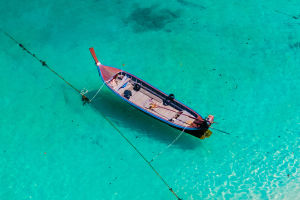The color variations between lake water and sea water present a captivating subject for exploration.
This phenomenon can be attributed to several factors, including the scattering and absorption of light, the distinct physical and chemical properties of lakes and oceans, and the influence of biological communities.
The green hue of lake water is mainly caused by the presence of phytoplankton. Phytoplankton, such as algae, engage in photosynthesis under sunlight, absorbing red and blue light while reflecting green light.
This process gives lake water its green appearance when illuminated by sunlight. Chlorophyll, a key pigment in phytoplankton, is responsible for this coloration.
Chlorophyll effectively absorbs blue and red light necessary for photosynthesis and reflects green light into the water. This reflected green light, combined with the scattering effect of the water, contributes to the greenish tint observed in lake water.
Moreover, the concentration of nutrients within the lake plays a crucial role in altering the color of the water. Nutrients such as nitrogen and phosphorus foster the rapid growth of phytoplankton, which intensifies the green color of the lake water.
In cases where a lake becomes polluted with excessive nutrients, a phenomenon known as a "water bloom" can occur. During such blooms, the algal population surges, causing the lake water to turn a darker green or even brown.
Seasonal and weather changes also influence the color of lake water. In summer, warmer water temperatures accelerate phytoplankton growth, enhancing the vibrancy of the lake's color.
Conversely, in winter, the reduced presence of phytoplankton causes the green color of the lake water to fade. On sunny days, the color of the lake water becomes more vivid when the sun directly illuminates the lake's surface, while on cloudy or rainy days, the watercolor may appear darker.
In contrast to lake water, the color of seawater is primarily affected by the scattering and absorption of light. The blue appearance of the ocean is largely due to these properties. Scattering refers to the deflection of light when it encounters water molecules and small particles.
In the ocean, light penetrates deeper into the water, and shorter-wavelength blue light is scattered more readily than longer-wavelength red light, resulting in the predominant blue hue of seawater.
The color of seawater is also influenced by dissolved substances. While seawater itself is colorless, it can dissolve and suspend a variety of substances, including minerals, organic matter, and plankton. These substances affect how light propagates and is absorbed.
For instance, suspended organic matter and sediments can alter the scattering pattern of light, thus impacting the color of seawater. Nevertheless, the scattering of blue light remains the primary factor contributing to the blue appearance of the ocean.
Furthermore, the depth of the ocean and the clarity of the water significantly affect the color of seawater. In shallow waters, where light can penetrate more deeply, the seawater may appear green or blue-green.
This is mainly due to the reflection of seaweed and plants growing at the bottom. In deeper waters, the limited penetration of light results in most of the blue light being scattered, leading to a purer blue appearance.
Seasonal and geographical factors also play a role in the color of seawater. In tropical regions, seawater is typically clearer, and the blue color is more pronounced.
In contrast, in temperate and polar regions, the high levels of suspended matter and increased biological activity can lead to variations in seawater color, such as green or gray.
The difference in color between lake water and seawater is primarily determined by factors such as the reflection characteristics of phytoplankton, the scattering and absorption properties of light, and nutrient concentrations.
Environmental conditions and seasonal changes also impact the color of these water bodies, allowing us to appreciate a diverse range of beautiful natural landscapes.


